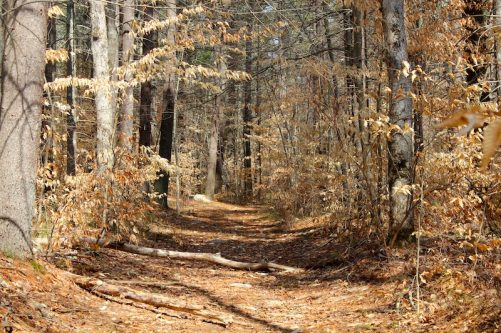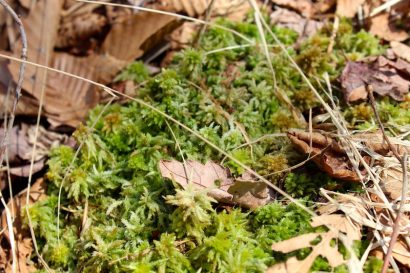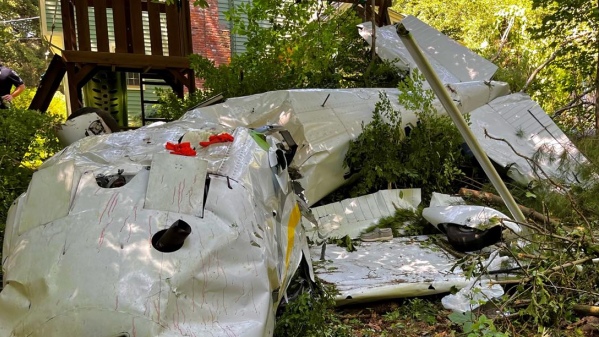
by Emily Neal
It has been a long, cold winter, and I have been really looking forward to getting back outside. As a dog owner, mom, and nature enthusiast, I am always searching for new places in the SouthCoast area to get out and go for a walk. Recently I found one: the Acushnet Cedar Swamp in New Bedford.
The Acushnet Cedar Swamp State Reservation encompasses over 1800 acres of wetlands in New Bedford and North Dartmouth. It contains an Atlantic White Cedar Swamp, a type of swamp characterized by thick stands of Atlantic White Cedar trees growing from moss-covered hummocks that rise from brownish water. This Atlantic White Cedar swamp was designated as a “National Natural Landmark” by the National Parks Service in 1972, and is only one of eleven Natural Landmarks in the state. It is one of the largest cedar swamps in Massachusetts, and is rumored to be exceptionally wild and impenetrable.

It is currently managed by the Massachusetts Department of Environmental Protection and is protected by the “Massachusetts Wetland Protection Act,” which regulates any activity that may affect the health of the swamp, like land clearing or filling. Atlantic White Cedar Swamps are a very unique and delicate ecosystem that only occur on the east coast; many are currently threatened by commercial and residential development.
Atlantic White Cedar (scientific name: Chamaecyparis thyoides) is an evergreen conifer tree that is in the Cypress family. It has soft, flat sprays of scaly leaves and tiny light-blue cones. The tree grows in a cone shape and can grow up to 80 feet tall. It is possible for these trees to live to 1,000 years but most live to around 200 years old. The wood of the cedar tree is very fragrant and durable. For over three hundred years it has been harvested in Massachusetts to be used for shingles, posts, fencing, boats, and more. Harvesting of wood these days is limited, however, due to the negative impacts that it has on the health of the swamp.
For much of the year the trees are partially submerged in standing water. They rely on regular water level fluctuations throughout the year in order to survive, which makes them especially vulnerable to land clearing for residential and commercial development which can change local water levels.
I have been excited to visit this site for some time. I have been to other Atlantic White Cedar Swamps, both on Cape Cod. There is a beautiful boardwalk trail through the cedar swamp in Welfleet, near Marconi beach. The boardwalk winds over the water between the trees, minimizing impact to the ecosystem but still allowing hikers to get a close-up look at this amazing ecosystem. Unfortunately, I wasn’t able to find any such boardwalk trail through the cedars here in New Bedford.
I did find a lesser-known entrance on the west side of the Reservation on High Hill Road in North Dartmouth. The entrance is marked by nothing more than a brown metal gate, and there are one or two spaces for cars by the side of the road. The trail leads into the woods and splits off toward private properties on a few occasions. The trail was wide and seemed relatively well maintained. Since three feet of winter snow just recently melted, the trail was very wet and at times nearly impassable. Other than the wetness, it was quite a pleasant walk. The trail seemed to skirt the edge of the Reservation and stayed upland from the swamp. We walked in dry, mixed woods the entire time, and I never saw a single cedar tree! I noticed mostly beech and pine trees, among other species that characterize these drier, upland areas associated with the Atlantic White Cedar Swamp.

I didn’t hike all of the way to the end of the trail. I am not sure if this trail even leads into the cedar swamp, or if it simply goes around it. I wouldn’t be surprised if the trail did not enter the wetland area unless there is a boardwalk, because the water would likely get very deep. I will go back to this site and explore further, however. There were a few side trails (watch out for those marked “Private Property”) that I want to explore, that appeared to head down in elevation a little bit (and possibly into the swamp itself). I think at this point I will wait until the ground dries out some more.
There is also access to the Acushnet Cedar Swamp at Turner Pond in New Bedford, and maybe there I will have some luck. Overall I had a very difficult time finding information about the swamp, and subsequently a way into the swamp, and I admit I still have some exploring to do. But I will continue my search, as these magical watery forests are well worth the effort.
 New Bedford Guide Your Guide to New Bedford and South Coast, MA
New Bedford Guide Your Guide to New Bedford and South Coast, MA








Unfortunately, you will have no luck accessing this beautiful area of Turner’s Pond from Old Plainville Road or Shawmut Avenue as the city of New Bedford has put logs in the parking area, thus preventing cars from entering. Individuals who wish to fish (catch and throw back) in Turner’s Pond can no longer take advantage of what their taxes pay for. Photographers can no longer navigate and capture the beauty of the seasons as parking is not an option. Why pay taxes if one cannot utilize the State Reservations which should be open to all residents?
Leave it to New Bedford to ruin a good thing. If leadership in NB can screw something up – they will. But hey – at least the city didn’t heavily leverage itself to make a ton of “upgrades” to the waterfront so they could serve as a terminal for an offshore wind farm….. a wind farm that anyone who looked at the facts without bias or through rose colored glasses could easily determine was never going to get built… Oh wait a minute… That’s NB for you… Well – at least the pier was buffed up for the working girls cruising the docks when the fishing boats come in.